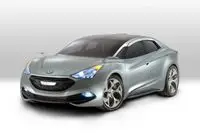Hyundai Fixes its 'i' on the Future
GENEVA – March 5, 2010: The 2010 Geneva Motor Show sees Hyundai Motor Company reveal its latest line up of Blue Drive™ models, led by the dramatic ‘i-flow’ concept vehicle which carries forward the company’s evocative new design architecture language, ‘fluidic sculpture’.
i-flow’s dynamic, elegant lines not only portray a futuristic silhouette, but also contribute to exceptional aerodynamics. Sporting intentions are emphasised through radical ideas, such as the arch-like roofline and streamlined front, which are supported by innovative active aero elements, such as the adaptive front spoiler and side rocker blades. A boat-tail shape and kick-up lines force the airflow to separate at the rear of the vehicle, leading to an impressive aerodynamic drag coefficient of just 0.25 Cd.
The fluidic forms of the exterior are echoed in i-flow’s cabin, where continuous lines sweep from the dashboard, through the doors to the open storage area at the rear. The seats were developed in conjunction with BASF using advanced stress analysis. ‘Steron’, (a BASF material), gives seats a highly-resilient quality, excellent breathability and a high-tech touch. The upper dashboard is treated with BASF’s ‘Elastoskin’, a sprayed skin which gives a sophisticated, shimmering finish. Finally, the cockpit’s main interface centres on an expansive contoured screen, which recognises not only touch, but also gestural inputs along its fascia-wide display.
Hyundai’s first diesel-electric hybrid powertrain integrates a new ‘U2’ 1.7-litre two-stage turbocharged engine and the company’s Lithium Ion-Polymer battery technology provides an efficient and advanced combination, enhanced by a six-speed, dual-clutch transmission. In addition the i-flow incorporates numerous new technologies - including the use of innovative lightweight materials, solar cells, energy conservation and harvesting techniques as well as excellent aerodynamics - all assisting in weight reduction and efficiency improvements which reduce the car’s CO2 output to an extraordinary 85g/km and fuel consumption to just 3L/100km.
The ix35 Hydrogen Fuel Cell Electric Vehicle (FCEV) is another exciting model on display and the latest addition to the Hyundai Blue Drive™ line-up of eco-focused vehicles. ix35 FCEV moves Hyundai closer to the commercialisation of hydrogen fuel cell electric vehicles, and incorporates several important innovations including the adoption of metallic separators (bipolar plates) in the fuel cell stack, and the use of 21kW LiPoly electrical storage batteries (already in mass production) which dramatically reduce cost and simplify the fuel cell manufacturing process.
Advances in modularisation reduce the time required in the final assembly process, and this combined with the Introduction of induction motors instead of permanent magnet-type motors assist greatly in achieving cost efficiencies and improving production scalability making FCEVs more economically feasible. By 2012, Hyundai plans to begin series manufacture of FCEVs for delivery to fleet customers in South Korea.
Other Blue Drive™ models on display include i10 blue, i20 blue and i30 blue, all offering sub-100g/km range CO2 emission levels, driving the company towards its target of global automotive leadership in environmentally-sensitive technologies



